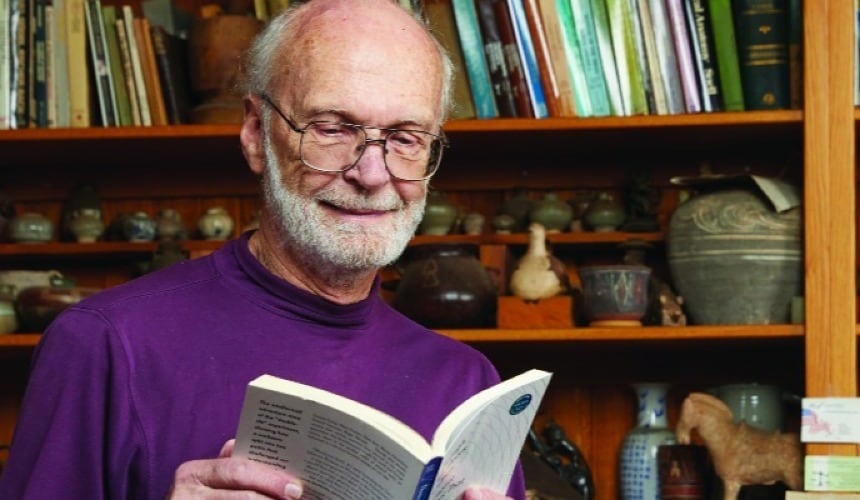
Quick Connections: How a Well-Integrated System Saved a Professor’s Brain
Donald Day went for a brain MRI for recurring headaches. The next day, he had brain surgery.
When 78-year-old Donald Day wasn’t advising his engineering students at Montgomery College, you could find him at home on his 26-acre hobby farm near Frederick, Maryland.
But when he began having severe headaches in spring 2019, his daily routine became a little more difficult.
“I’ve had Lyme disease for over 30 years, and headaches have been one of the most recurrent symptoms,” Donald said. “I just assumed it was the disease acting up again, but these were different than the normal ones – they were much more intense.”
He made an appointment with his primary care physician, who prescribed two months of antibiotics. When the headaches didn’t go away, his doctor sent him for a brain MRI.
Donald was collecting his things at the imaging center, getting ready to leave, when a staff member stopped him.
“They told me my doctor was on the phone and needed to speak to me immediately,” he said.
When Donald got on the phone, his doctor told him to stay at the imaging center. A car was coming to get him and bring him to the Emergency Department at Adventist HealthCare Shady Grove Medical Center.
“My doctor told me to wait patiently, and that he was calling a neurosurgeon,” Donald said. “He told me I needed surgery right away.”
Interconnected Care
Donald arrived at Shady Grove Medical Center and within hours received additional imaging and was being prepped for surgery. It was then that he met Amin Amini, MD, medical director of neurosurgery for Adventist HealthCare.
“Donald was suffering from a subdural hematoma, which is bleeding in the brain,” Dr. Amini said. “Because of the size, we needed to operate right away to relieve the pressure on the brain.”
The next morning, Dr. Amini performed a craniotomy to remove Donald’s hematoma.
“This is the most common type of brain surgery we perform, and we normally have a great outcome,” Dr. Amini said. “Donald’s case was no different.”
Removing a subdural hematoma involves opening the skull and suctioning out the blood. Following the surgery, the Intensive Care Unit at Shady Grove monitored Donald for two days.
“I remember waking up in the room, and Dr. Amini was standing by my bed. He smiled and said, ‘It went great, and we’re all done!’” Donald said.
After follow-up imaging to ensure all was well, Donald’s next step was rehabilitation.
“Our goal in these cases is always to get our patients moving again,” Dr. Amini said. “It’s very important to get them up and mobile quickly, so they can return to their normal lives as soon as possible.”
Physicians from Adventist HealthCare Rehabilitation visited Donald at Shady Grove to determine whether he was ready for rehabilitation. They evaluated, cleared and transferred Donald to Adventist HealthCare’s inpatient rehab hospital, next door to Shady Grove.
“Having direct connections with Rehabilitation makes it much easier for us to have our patients evaluated, and really expedites the healing process for our patients,” Dr. Amini said. “It’s also convenient for our patients because they don’t have to move far.”
Back On The Move
When Donald arrived at Adventist HealthCare Rehabilitation, the care team’s priority was getting him up and walking. Upon arrival, he was evaluated by physical, occupational and speech therapists.
“When Donald first got to us, he was having some difficulty with balance and coordination,” said Ashley Morrow Johnson, a speech-language pathologist. “But he was what I would consider the perfect patient. He was highly motivated, willing to learn and hardworking regardless of his challenges.”
Donald grew close with the staff at Rehabilitation, who gave him the nickname “Triple D.” Along with his speech and occupational therapy, the team brought Donald to the Rehabilitation gym to lift weights and work on his balance. Within two weeks, he was stable enough to return home to his farm.
“He progressed quickly and met all of his therapy goals,” Ashley said. “But most importantly, he was finally ready to go home, which was his ultimate goal!”
Now, Donald is back to advising his students and spending free time on his farm.
“I still remember getting out of the car after rehab, and letting my feet get used to the ground here again,” Donald said. “It took me some time to get used to everything, but boy, was I glad to be home. I still am.”